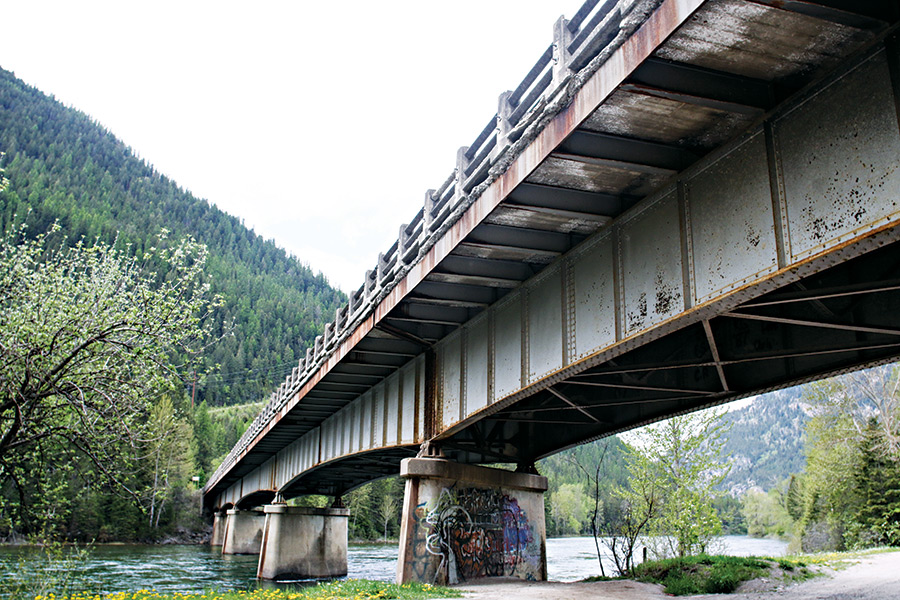South Fork Bridge Replacement, U.S. 2 Reconstruction Slated for Next Summer
Transportation officials preparing to rebuild Hungry Horse bridge, improve highway through Bad Rock Canyon
By Dillon Tabish
As the U.S. Highway 93 Alternate Route in Kalispell approaches completion this fall, transportation officials are turning their attention to the next significant road project in Northwest Montana: a long-awaited reconstruction of U.S. Highway 2 through Bad Rock Canyon.
Revamping the narrow, two-lane highway that winds from Columbia Falls to Hungry Horse and replacing the bridge over the South Fork Flathead River have been long-standing priorities for the Montana Department of Transportation. With the help of two federal grants, the project is fully funded and the state agency is moving forward with a tentative timeline of breaking ground next summer.
Ed Toavs, MDT’s district administrator, said the project is near the end of the design phase and bids could open by March 2017. Work could begin by May or June of next year, Toavs said.
“We’ve been looking forward to this project for a long time,” he said.
The project, estimated to cost roughly $16 million, will include reconstructing 4.5 miles of highway near the entrance to Hungry Horse to Bad Rock Canyon. The new highway will include a shared-use path on the river-side of the road for pedestrians and cyclists. There will also be wider shoulders added to the road.
The new bridge will be built just to the west of the current structure, which was originally constructed in 1938. Both the bridge and the rebuilt road will remain two lanes. The bridge will be designed so an additional two lanes could be added in the future. The alignment will reduce the highway’s sharp curve and will also include a 10-foot wide walkway.
Construction will not interfere with summer traffic, Toavs said, and vehicles will still use the current bridge while the new structure is developed.
“There won’t be any detour,” he said.
A 2012 study determined that the bridge is functionally obsolete and structurally deficient, and many aspects of the structure do not meet modern transportation design standards.
Nearly 14,000 vehicles travel through the corridor on an average summer day, according to MDT statistics. The annual average is nearly 7,000 daily vehicles.
The crash rate for the U.S. 2 corridor was nearly 2.5 times higher than the statewide average, according to a 2006-10 study. The severity rate was more than three times higher than the statewide average. There were 45 injuries and five fatalities during that time period.
After the reconstruction is completed, MDT will have 1.5 miles of U.S. 2 that still need to be revamped. The stretch of road that is most narrow through Bad Rock Canyon presents multiple challenges, Toavs said.
The rocky canyon that parallels the highway is unstable in some areas, making it difficult to drill into the mountainside to widen the road any further, Toavs said. On the other side of the road, the river traces the highway, creating another challenge when it comes to widening the route. Also, Columbia Mountain holds a spiritual and cultural significance to several local tribes. The primary natural gas line to the Flathead Valley also runs underneath U.S. 2, adding another element that complicates any construction.
“There are all kinds of issues,” Toavs said.
But Toavs said reconstructing the final narrow stretch of highway remains a priority, along with adding a shared-use path that would complete the pedestrian route from Columbia Falls to Hungry Horse.
“It’s very much a needed project. It’s just a matter of solving these issues and finding funding,” Toavs said.
Several other smaller transportation projects are slated for the coming years in the Flathead Valley. MDT is working to rehabilitate stretches of Montana Highway 206 south of Columbia Falls. Plans are being developed to add a shoulder to the narrow, two-lane road, which has seen an influx of traffic in recent years.
MDT plans to work with Kalispell to address heightened traffic flows on West Reserve Drive near Whitefish Stage Road, as well as Willow Glen, Toavs said.
The state agency also plans to repave primary sections of road through Columbia Falls and Evergreen next year, according to Toavs.